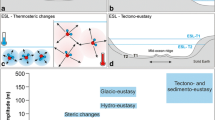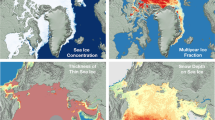Abstract
Using Microwave Sounding Unit (MSU) channel 2 (Ch. 2, 53.74 GHz) data, Spencer and Christy (1992a) determined that the earth exhibits no temperature trend in the period 1979–90, while other authors find a temperature increase of roughly 0.1 K. Based on a theoretical analysis Prabhakara et al. (1995) showed that the information about the global atmospheric temperature deduced from MSU Ch. 2 observations has a small contamination, δT 2, as a result of the attenuation due to hydrometeors in the atmosphere. A method is developed in this study, that utilizes coincident measurements made by MSU in Ch. 1 (50.3 GHz), to estimate this δT 2 over the global oceans. The magnitude of δT 2 is found to be about 1 K over significant parts of the tropical oceanic rain belts and about 0.25 K over minor portions of the mid-latitude oceanic storm tracks. Due to events such as El Niôo, there is variability from year to year in the rain areas and rain intensity leading to significant change in the patterns of δT 2. The patterns of δT 2 derived for March 82 and March 83 reveal such a change. When averaged over the global oceans, from 50° N to 50° S, δT 2 has a value of 0.25 and 0.29 K for March 1982 and 1983, respectively. Due to these reasons the interannual temperature change derived by Spencer and Christy from MSU Ch. 2 will contain a residual hydrometeor effect. Thus in evaluating decadal trend of the global mean temperature of the order of 0.1 K from MSU Ch. 2 data one has to take into account completely the contamination due to hydrometeors.
Similar content being viewed by others
References
Angell, J. K.: 1988, ‘Variations and Trends in Tropospheric and Stratospheric Global Temperatures, 1958–87’, J. Climate 1, 1296–1313.
Hansen, J. and Wilson, H.: 1993, ‘Commentary on the Significance of Global Temperature Records’, Climatic Change 25, 185–191.
Hinton, B. B., Olson, W. S., Martin, D. W., and Auvine, B.: 1992, ‘A Passive Microwave Algorithm for Tropicsl J.Oceanic Rainfall’, J. Appl. Meteorol. 31, 1379–1395.
Oort, A. H. and Liu, H.: 1993, ‘Upper-Air Temperature Trends over the Globe, 1958–1989’, J. Climate 6, 292–307.
Prabhakara, C., Nucciarone, J. J., and Yoo, J.-M.: 1995, ‘Examination of “Global Atmospheric Temperature Monitoring With Satellite Microwave Measurements”: 1. Theoretical Considerations‘, Climatic Change 30, 349–366.
Prabhakara, C., Dalu, G., Liberti, G. L., Nucciarone, J. J., and Suhasini, R.: 1992, ‘Rainfall Estimation over Oceans from SMMR and SSM/I Microwave Data’, J. Appl. Meteorol. 31, 532–552.
Prabhakara, C., Short, D. A., Wiscombe, W., Fraser, R. A., and Vollmer, B. E.: 1986, ‘Rainfall over Oceans Inferred from Nimbus 7 SMMR’, J. Climate Appl. Meteorol. 25, 1464–1474.
Rasmusson, E. M. and Wallace, J. M.: 1983, ‘Meteorological Aspects of the El Niôo/Southern Oscillation’, Science 222, 1195–1202.
Saucier, W. J.: 1955, Principles of Meteorological Analysis, Univ. Chicago Press, 438 pp.
Spencer, R. W. and Christy, J. R.: 1990, ‘Precise Monitoring of Global Temperature Trends from Satellites’, Science 247, 1558–1562.
Spencer, R. W., Christy, J. R., and Grody, N. C.: 1990, ‘Global Atmospheric Temperature Monitoring with Satellite Microwave Measurements: Method and Results, 1979–1984’, J. Climate 3, 1111–1128.
Spencer, R. W. and Christy, J. R.: 1992a, ‘Precision and Radiosonde Validation of Satellite Gridpoint Temperature Anomalies, Part I: MSU Channel 2’, J. Climate 5, 847–857.
Spencer, R. W. and Christy, J. R.: 1992b, ‘Precision and Radiosonde Validation of Satellite Gridpoint Temperature Anomalies, Part II: A Tropospheric Retrieval and Trends during 1979–90’, J. Climate 5, 847–857.
Trenberth, K. E., Christy, J. R., and Hurrell, J. W.: 1992, ‘Monitoring Global Monthly Mean Surface Temperatures’, J. Climate 5, 1405–1423.
Wu, R. and Weinman, J. A.: 1984, ‘Microwave Radiances from Precipitating Clouds Containing Aspherical Ice, Combined Phase, and Liquid Hydrometeors’, J. Geophys. Res. 89, 7170–7178.
Author information
Authors and Affiliations
Rights and permissions
About this article
Cite this article
Prabhakara, C., Yoo, JM., Maloney, S.P. et al. Examination of ‘global atmospheric temperature monitoring with satellite microwave measurements’: 2. Analysis of satellite data. Climatic Change 33, 459–476 (1996). https://doi.org/10.1007/BF00141699
Received:
Revised:
Issue Date:
DOI: https://doi.org/10.1007/BF00141699




